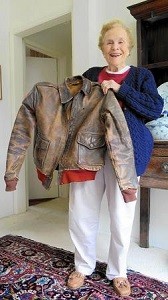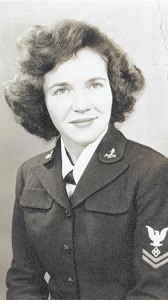The “Greatest Generation” is rapidly becoming the “disappearing generation.”
Of the 16 million men and women who served in uniform during World War II, their numbers are expected to dwindle to less than a half-million by the end of this year, according to the U.S. Dept. of Veterans Affairs.
Of these remaining veterans, whose ages range from 88 to 100-plus, many today are showing an eagerness, an almost compelling urgency, to share their wartime stories with family, friends and neighbors as their ranks continue to diminish with the passing of time.
One of these is Betty Storch, a 66-year Newport Beach resident who served during WWII in the Waves, the Navy’s branch for women. Stationed at bases in the continental United States and the then-territories of Hawaii and Alaska, an estimated 84,000 Waves held positions such as clerks, secretaries, radio and radar operators, photographers, journalists, postmasters, intelligence analysts and even parachute riggers.
Storch, who will turn 96 on June 2, also takes pride in recounting the wartime exploits of her late husband, Lt. Col. John A. Storch, a WWII “double ace” Army Air Corps pilot, who moved with Betty to Newport in 1951 and became an oil company executive and civic leader.
While at Berkeley, Storch met a young Navy officer who was training to be a pilot. They began dating and had an “understanding.” At the time, however, the Navy did not permit its pilots to marry until they had completed their flight training and received their wings. He was killed during a training mission when his plane crashed near Corpus Cristi, Texas, just prior to his graduation from flight school.
“As soon as I graduated from Berkeley, I joined the Waves. Because I had a college degree, I was eligible to attend officers school, but chose to join the enlisted ranks and was sent for training to Hunter College in New York City and then to Syracuse University in upper New York state,” she said.
When her training ended, Storch was designated a postal clerk and assigned to duty in San Francisco, which was fortunate for her because it was comparatively near her Bakersfield home.
“I roomed with another Wave at a hotel on Geary Street, just two blocks from Union Square, and my duty station was at the Navy’s West Coast postal facility on Brannan Street, just south of Market Street.
“An important part of my assignment was my access to the Navy’s code sheet, which revealed the top-secret locations of all ships in the U.S. Pacific Fleet.”
As soon as these ships docked at San Francisco-area Navy bases, their crewmen would rush to her postal facility to pick up their mail. The sailors were “exhausted and war-torn,” and she was able to learn from the code sheet when they would have to reboard their ships and sail off for further combat duty in the far Pacific,” Storch said.
In October 1945, a month after the Japanese surrendered and the war ended, Storch was mustered out of the Navy with the rank of petty officer, second class, following two years of active duty in San Francisco.
A day or so before she left the service, “a military doctor gave me some sort of injection. I don’t remember what it was for, but I got deathly sick and was in bed for a week when I got home to Bakersfield,” she said.
A few weeks later, she received an invitation to attend a local ball honoring Navy and Army officers who also had recently left the service. She didn’t want to go because she hadn’t dated anyone since her boyfriend had been killed.
“But my mother persuaded me to attend, and at the party I met an Army pilot named Lt. Col. John A. Storch, who had just returned from duty in Europe,” she said. “We hit it off right then, we began dating and 11/2 years later we were married at St. Francis Catholic Church in Bakersfield. I wore a white wedding gown with a white lace veil. John was 30 and I was 25.”
John Storch, who grew up in Long Beach, had also graduated from UC Berkeley, receiving a bachelor’s degree in economics and business administration in 1941. He then joined the Army Air Corps (which became the U.S. Air Force in 1946), won his wings and was assigned to the 357th Fighter Group stationed near the tiny village of Yoxford in east-central England, about 90 miles from London.
One of his fellow pilots and friends was Chuck Yeager, a “double-ace” pilot who shot down 11 German aircraft and, in 1953, broke the sound barrier when he flew at mach 2.44 or 1,872 miles per hour during a test flight over the Mojave Desert.
Flying from Yoxford in his P-51 “Mustang” single-seat, long-range fighter bomber he named “Shillelagh,” after the Irish word meaning cudgel or heavy club, Storch also became a double-ace after he, too, downed 11 German airplanes, over Leipzig, Dresden and Berlin.
Following his military service (he was awarded the Silver Star, Air Medal, three Distinguished Flying Crosses and the French Croix de Guerre) and his marriage to Betty, John was employed by the Petrolane Oil Co. in Bakersfield. The firm transferred him to its headquarters in Long Beach, and the Storches moved to the Bayshores community in Newport Beach, where Betty still lives.
The Storches had four children in five years. Two of them, Dr. John Storch, an internist, and Anne Seagren, a computer specialist, live in Newport Beach. The other two, Sally Turner, an artist who paints under the name of Sally Storch, and Judy Esparros, a television anchorwoman whose professional name is Judy Storch, live in Pasadena.
“Our four children have given me 13 wonderful grandchildren,” said Betty.
After their move to Newport Beach, Betty and John became heavily involved in community affairs. Betty was active in the Assistance League and as a volunteer at Hoag Memorial Hospital Presbyterian and John, who had been promoted to a Petrolane vice-presidency, served on the Orange County Jury, was a longtime Hoag fundraiser and a member of Big Canyon Country Club’s “Hole-in-One” club.
Betty laughed when reminiscing about John’s purchase of a 36-foot Grand Banks trawler.
“He took lessons on how to operate the boat, and two months later, we sailed to Catalina,” she said. “He put on a coat and tie for the trip, but I made him change into more casual clothes. When we got to the island, we moored the boat in Avalon harbor for about 10 minutes and then came back home. John took a few fishing trips on the boat after that. But one day he told me, ‘I’d rather play golf’ and sold the boat for what he paid for it, which was about $50,000.”
John Storch died at age 68 in May 1985 after a long battle with dementia. A Daily Pilot news story on his passing carried the headline, “Active in Civic Affairs, John Storch, WWII Air Ace, Dies.”
Betty, who is still active in community affairs and says her health is “fine,” often recalls her WWII service in the Waves, but believes her Navy postal job was “somewhat mundane.”
It wasn’t. All World War II veterans, whether or not they served on the front lines, played a role that helped lead America to victory.


